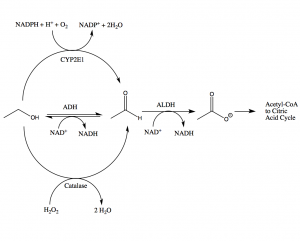The Biological Pathway
Ethanol is mainly oxidized to acetaldehyde through three different enzymes: alcohol dehydrogenase, cytochrome P450 2E1, and catalase. To avoid acetaldehyde’s toxic effects, after it is produced, acetaldehyde must be oxidized to acetate by aldehyde dehydrogenase. Acetate can be catalyzed to acetyl-CoA by acetyl-CoA synthetase, and the acetyl-CoA formed can feed into the citric acid cycle or be used in lipid biosynthesis (5).

November 7, 2016 at 7:16 pm
Honestly I think this is exactly the figure that was missing from “the Answer” page! I think your caption could be slightly more descriptive. I know when I look at a figure, especially if it’s before the paragraphs of text, I don’t want to have to look through the paragraphs in order to know what “ALDH” stand for, for example. (Or you could write out “aldehyde dehyrdrogenase” on the figure, it’s not that long).
Also, why is the conversion of acetate to acetyl-CoA shown as multiple steps when you describe it as only one enzyme?
November 10, 2016 at 5:18 pm
Like Delia, I am also interested as to why the conversion of acetate to acetyl Co-A is multiple steps.
My only other revision is that you mention the acetyl Co-A created can be used in the CAC or for lipid biosynthesis, but only mention the CAC in the diagram. Would it be possible to add a second arrow indicating the alternative lipid biosynthesis outcome?
November 11, 2016 at 8:21 am
Do you remember the graphs Dr. Pamuk has made in class for glucose metabolism that show the primary processes happening at certain time points? (i.e. in the first several hours post eating glycolysis provides energy, then glycogen breakdown can provide energy for 24-48 hours, then gluconeogenesis, muscle breakdown, and lipid breakdown begin to occur). I think it would help summarize alcohol metabolism to do a similar graph showing ADH, CYP450 and catalase activity as a function of alcohol ingested, since these enzymes catalyze the same reaction. Your next three pages do a really great job of explaining how these enzymes adapt as alcohol consumption rises, and it could be a good visual highlight.
August 22, 2023 at 3:46 am
Thanks for your post on this web site. From my own experience, there are times when softening right up a photograph might provide the digital photographer with a little an artsy flare. Oftentimes however, this soft clouds isn’t what exactly you had at heart and can quite often spoil an otherwise good photograph, especially if you consider enlarging that.
August 23, 2023 at 12:24 pm
I delight in, lead to I found just what I used to be having a look for. You’ve ended my four day lengthy hunt! God Bless you man. Have a great day. Bye
August 24, 2023 at 4:58 pm
Can I just say what a aid to find someone who really is aware of what theyre speaking about on the internet. You undoubtedly know how to bring an issue to gentle and make it important. Extra people have to learn this and understand this side of the story. I cant consider youre not more in style since you definitely have the gift.
August 25, 2023 at 4:27 pm
I am extremely impressed with your writing skills as well as with the layout on your weblog. Is this a paid theme or did you modify it yourself? Anyway keep up the nice quality writing, it?s rare to see a nice blog like this one these days..
August 27, 2023 at 7:20 pm
It?s actually a cool and helpful piece of info. I?m satisfied that you simply shared this helpful information with us. Please stay us informed like this. Thanks for sharing.
August 28, 2023 at 8:37 am
Thanks for the interesting things you have unveiled in your short article. One thing I’d prefer to reply to is that FSBO interactions are built eventually. By introducing yourself to owners the first saturday and sunday their FSBO can be announced, before the masses begin calling on Thursday, you create a good relationship. By mailing them instruments, educational materials, free accounts, and forms, you become the ally. Through a personal affinity for them plus their scenario, you generate a solid link that, most of the time, pays off when the owners decide to go with a realtor they know in addition to trust – preferably you actually.
August 29, 2023 at 5:35 pm
I have learned result-oriented things by your weblog. One other thing I would like to say is that newer laptop operating systems have a tendency to allow much more memory to be played with, but they furthermore demand more ram simply to function. If someone’s computer cannot handle additional memory and the newest program requires that memory space increase, it usually is the time to shop for a new Computer. Thanks
August 30, 2023 at 8:07 pm
bird watching danube delta
August 31, 2023 at 2:44 pm
After study a few of the weblog posts in your web site now, and I really like your approach of blogging. I bookmarked it to my bookmark website checklist and will probably be checking again soon. Pls take a look at my website as effectively and let me know what you think.
September 4, 2023 at 7:16 am
Hi there, simply become aware of your blog thru Google, and found that it is really informative. I?m going to watch out for brussels. I?ll appreciate in case you proceed this in future. Lots of people will be benefited from your writing. Cheers!